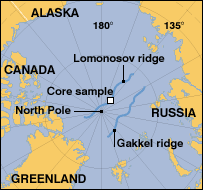February 24, 2016
The enigmatic Arctic
Warmists have long been fascinated by the temperature fluctuations of the Arctic -- mainly because it is the only part of the globe that has warmed up significantly in recent years. They hint that Arctic warming proves global warming but fail to explain how. The whole point of the matter is surely that the Arctic warming is NOT global so how is it a proof of something global?
In fact, one could argue that Arctic warming is so anomalous that it should be excluded from global figures. That would be an "adjustment" or "correction" well in line with what Warmists routinely do to the temperature record. And if one did make the correction, what would we see? GLOBAL COOLING! How strange that the adjustment kings at NOAA, NASA and elsewhere don't make that correction! Tom Karl, are you listening?
But the erratic Arctic has just excelled itself. It showed a huge temperature leap in January and the Warmists don't know why. The pesky old Arctic has made it abundantly clear that it runs its own race and is not part of global temperature trends.
But the Warmists are puzzled by what is going on in the Arctic only because they keep their eyes firmly closed to things that lie outside their normal areas of discourse. If we broaden our vision slightly, we would conclude that the erratic Arctic is exactly what we would expect if there was a lot of volcanic activity under its floating ice. Volcanoes are hot but erratic.
And that is in fact exactly what we have in the Arctic. Most of the Arctic is covered not by land but by floating ice (sea ice) and close to the center of the action is the undersea Gakkel ridge -- which has more volcanic activity than anywhere else on earth. And those volcanoes are BIG. And all that has been known for a long time now. See here.
So the only mystery about Arctic temperatures is why they are thought to be an effect of climate.
New data from NASA and the National Oceanic and Atmospheric Administration suggest that January of 2016 was, for the globe, a truly extraordinary month.
Coming off the hottest year ever recorded (2015), January saw the greatest departure from average of any month on record, according to data provided by NASA.
But as you can see in the NASA figure above, the record breaking heat wasn’t uniformly distributed — it was particularly pronounced at the top of the world, showing temperature anomalies above 4 degrees Celsius (7.2 degrees Fahrenheit) higher than the 1951 to 1980 average in this region.
Indeed, NASA provides a “zonal mean” version of the temperature map above, which shows how the temperature departures from average change based on one’s latitude location on the Earth. As you can see, things get especially warm, relative to what the Earth is used to, as you enter the very high latitudes:
Global warming has long been known to be particularly intense in the Arctic — a phenomenon known as “Arctic amplification” — but even so, lately the phenomenon has been extremely pronounced.
This unusual Arctic heat has been accompanied by a new record low level for Arctic sea ice extent during the normally ice-packed month of January, according to the National Snow and Ice Data Center — over 400,000 square miles below average for the month. And of course, that is closely tied to warm Arctic air temperatures.
“We’ve looked at the average January temperatures, and we look at what we call the 925 millibar level, about 3,000 feet up in the atmosphere,” says Mark Serreze, the center’s director. “And it was, I would say, absurdly warm across the entire Arctic Ocean.” The center reports temperature anomalies at this altitude of “more than 6 degrees Celsius (13 degrees Fahrenheit) above average” for the month.
The low sea ice situation has now continued into February. Current ice extent is well below levels at the same point in 2012, which went on to set the current record for the lowest sea ice minimum extent:
“We’re way down, we’re at a record low for this time of year right now,” says Serreze. When it comes to the rest of 2016 and the coming summer and fall season when ice melts across the Arctic and reaches its lowest extent, he says, “we are starting out in a deep hole.”
So what’s causing it all? It’s a complicated picture, say scientists, but it’s likely much of it has to do with the very strong El Niņo event that has carried over from 2015. But that’s not necessarily the only factor.
“We’ve got this huge El Niņo out there, we have the warm blob in the northeast Pacific, the cool blob in the Atlantic, and this ridiculously warm Arctic,” says Jennifer Francis, a climate researcher at Rutgers University who focuses on the Arctic and has argued that Arctic changes are changing mid-latitude weather by causing wobbles in the jet stream. “All these things happening at the same time that have never happened before.”
Serreze agrees that the El Niņo has something to do with what’s happening in the Arctic. “I think this is more than coincidence. That we have this very strong El Niņo at the same time when we have this absurd Arctic warmth. But exactly what the details are on that, I don’t think we can say right now,” he says.
In Alaska, matters have been quite warm but not record-breaking this winter, says Rick Thoman, climate science and services manager for the National Weather Service in the state.
“I think this winter is going to get studied like crazy, for quite a while,” says Francis. “It’s a very interesting time.”
SOURCE
Go to John Ray's Main academic menu
Go to Menu of longer writings
Go to John Ray's basic home page
Go to John Ray's pictorial Home Page
Go to Selected pictures from John Ray's blogs
